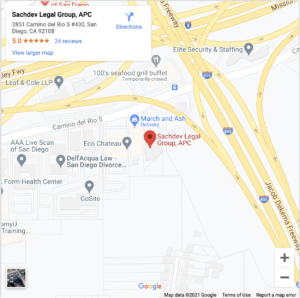Puja Sachdev | March 23, 2023 | Child Custody
Child custody is often a core issue in a California divorce proceeding. Family courts in the state generally encourage parents to work with each other to create a custody arrangement in the best interests of the child.
However, the divorce process can take time, and child custody disputes may not be resolved until months after the initial papers are filed. As a result, California family courts sometimes allow parents to petition for and receive a temporary emergency custody order.
This blog post will explain how to get emergency custody in California and what to watch out for.
What Is Emergency Custody in California?
Emergency custody is when courts impose interim child custody conditions on divorcing parents before their separation proceedings are finalized. Temporary emergency custody orders are considered “ex parte” orders, meaning the requesting parent can receive one without the presence or input of the other parent.
California courts only issue emergency custody orders in rare circumstances. Specifically, there must be an immediate danger of irreparable harm to the child. Situations that could lead to emergency custody include, but are not limited to, the following:
- A parent intends to move the child to another state or country
- Domestic violence accusations
- Allegations of child abuse or neglect
- A parent is unfit to care for the child due to a mental condition, drug abuse, or other similar conditions
- A parent refuses to allow the other parent to see or visit the child
California family law courts do not easily award emergency child custody, in part because the other parent does not generally have the chance to provide their version of the events in question.
The Process of Receiving Emergency Custody of Your Child in California
Several steps are involved in getting emergency custody of your child in the State of California:
- First, you’ll need to identify the proper court to submit your request to as well as its associated local rules. The process can vary from court to court.
- You must fill out a “Request for Order” form FL-300 and the FL-305 form.
- As the requesting party, you must submit evidence to establish that emergency custody is appropriate. You can offer evidence such as photographs, medical records, police reports, and more.
- You must generally give notice and serve process to the other parent or their attorney that you are filing for emergency custody. Form FL-305 is sufficient in most cases to demonstrate you’ve met this requirement.
- Submit each form to the court. Depending on the facts of the case, there may be an emergency custody hearing.
- If the court agrees with your request, you may be granted temporary emergency custody of the child. This will remain in place until a full hearing is held on the matter.
The exact procedures involved in your situation will depend on various factors, so not all emergency custody matters will necessarily follow these same steps.
An Experienced Family Law Attorney Can Help
If you are considering submitting a request for emergency custody, you will almost certainly benefit from a family lawyer’s assistance. Courts are reluctant to award “ex parte” orders, and you must present significant evidence in favor of your contentions.
Without legal representation, you run the risk of presenting an insufficient case – even if your request has merit in reality. The stakes cannot be higher when it comes to obtaining emergency custody of your child and presenting as strong a request as possible is critical.
Since most family lawyers offer a complimentary case evaluation to review your situation, it is at least worth your time to reach out to find out whether you need help from an attorney.
Contact Our Child Custody Law Firm in San Diego, CA
Contact our experienced San Diego divorce lawyers at San Diego Divorce Lawyers, APC today for legal assistance. Contact our San Diego office at (619) 866-3756 to schedule a consultation.
San Diego Divorce Lawyers, APC
2851 Camino del Rio S #430
San Diego, CA 92108
